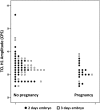Oxidative markers in cryopreservation medium from frozen-thawed embryos: a possible tool for improved embryo selection in in vitro fertilization?
- PMID: 26973335
- PMCID: PMC4889477
- DOI: 10.1007/s10815-016-0692-6
Oxidative markers in cryopreservation medium from frozen-thawed embryos: a possible tool for improved embryo selection in in vitro fertilization?
Abstract
Purpose: The present study evaluated the association between oxidative parameters in embryo cryopreservation medium and laboratory and clinical outcomes.
Methods: This prospective laboratory study was conducted in an IVF unit in a university-affiliated hospital with 91 IVF patients undergoing a frozen-thawed embryo transfer cycle. Following thawing, 50 μL of embryo cryopreservation medium was retrieved from each cryotube and tested by the thermochemiluminescence (TCL) assay. TCL amplitudes after 50 (H1), 150 (H2), and 280 s (H3) were recorded in counts per second (CPS) and the TCL ratio determined for comparison with implantation and pregnancy rates.
Results: A total of 194 embryos were transferred in 85 frozen-thaw cycles. Twenty-one pregnancies (24.7 %) occurred. Implantation and overall and clinical pregnancy rates were higher when the median TCL H1 amplitude was <32 CPS compared to ≥32 CPS (14.6 vs. 5.3 %, 37.5 vs. 17 %, 28.1 vs. 9.4 %, respectively). No pregnancies occurred when the H1 amplitude was ≥40 CPS. Logistic regression multivariate analysis found that only the median TCL H1 amplitude was associated with the occurrence of pregnancy (OR = 2.93, 95 % CI 1.065-8.08). The TCL ratio inversely correlated with the duration of embryo cryopreservation (r = -0.37).
Conclusions: The results indicate that thawed embryos may express oxidative processes in the cryopreservation medium, and higher oxidative levels are associated with lower implantation rates. These findings may aid in the improved selection of frozen-thawed embryos for IVF.
Keywords: Cryopreservation; Embryo; IVF; Oxidation; Pregnancy.
Figures


Similar articles
-
The influence of the type of embryo culture medium on neonatal birthweight after single embryo transfer in IVF.Hum Reprod. 2012 Sep;27(9):2619-26. doi: 10.1093/humrep/des252. Epub 2012 Jul 12. Hum Reprod. 2012. PMID: 22791752
-
Can cumulative pregnancy rates be increased by freezing and thawing single embryos?Fertil Steril. 2009 Feb;91(2):395-400. doi: 10.1016/j.fertnstert.2007.11.074. Epub 2008 Mar 4. Fertil Steril. 2009. PMID: 18295209
-
[Clinical effects of oocyte cryopreservation in assisted reproduction technology].Zhonghua Yi Xue Za Zhi. 2008 Oct 28;88(39):2755-8. Zhonghua Yi Xue Za Zhi. 2008. PMID: 19080449 Chinese.
-
Cryopreservation of human embryos and its contribution to in vitro fertilization success rates.Fertil Steril. 2014 Jul;102(1):19-26. doi: 10.1016/j.fertnstert.2014.05.027. Epub 2014 Jun 2. Fertil Steril. 2014. PMID: 24890275 Review.
-
Implantation potential and clinical impact of cryopreservation--a review.Placenta. 2003 Oct;24 Suppl B:S27-33. doi: 10.1016/s0143-4004(03)00133-4. Placenta. 2003. PMID: 14559027 Review.
Cited by
-
Effect of post-warming culture time on the live birth rate after frozen embryo transfer.Reprod Med Biol. 2022 May 30;21(1):e12465. doi: 10.1002/rmb2.12465. eCollection 2022 Jan-Dec. Reprod Med Biol. 2022. PMID: 35662890 Free PMC article.
-
Oxidative Stress and Assisted Reproduction: A Comprehensive Review of Its Pathophysiological Role and Strategies for Optimizing Embryo Culture Environment.Antioxidants (Basel). 2022 Feb 28;11(3):477. doi: 10.3390/antiox11030477. Antioxidants (Basel). 2022. PMID: 35326126 Free PMC article. Review.
References
-
- Wiener-Megnazi Z, Lahav-Baratz S, Rothschild E, Abramovici H, Dirnfeld M. Impact of cryopreservation and subsequent embryo transfer on the outcome of in vitro fertilization in patients at high risk for ovarian hyperstimulation syndrome. Fertil Steril. 2002;78:201–203. doi: 10.1016/S0015-0282(02)03190-4. - DOI - PubMed
MeSH terms
Substances
LinkOut - more resources
Full Text Sources
Other Literature Sources

